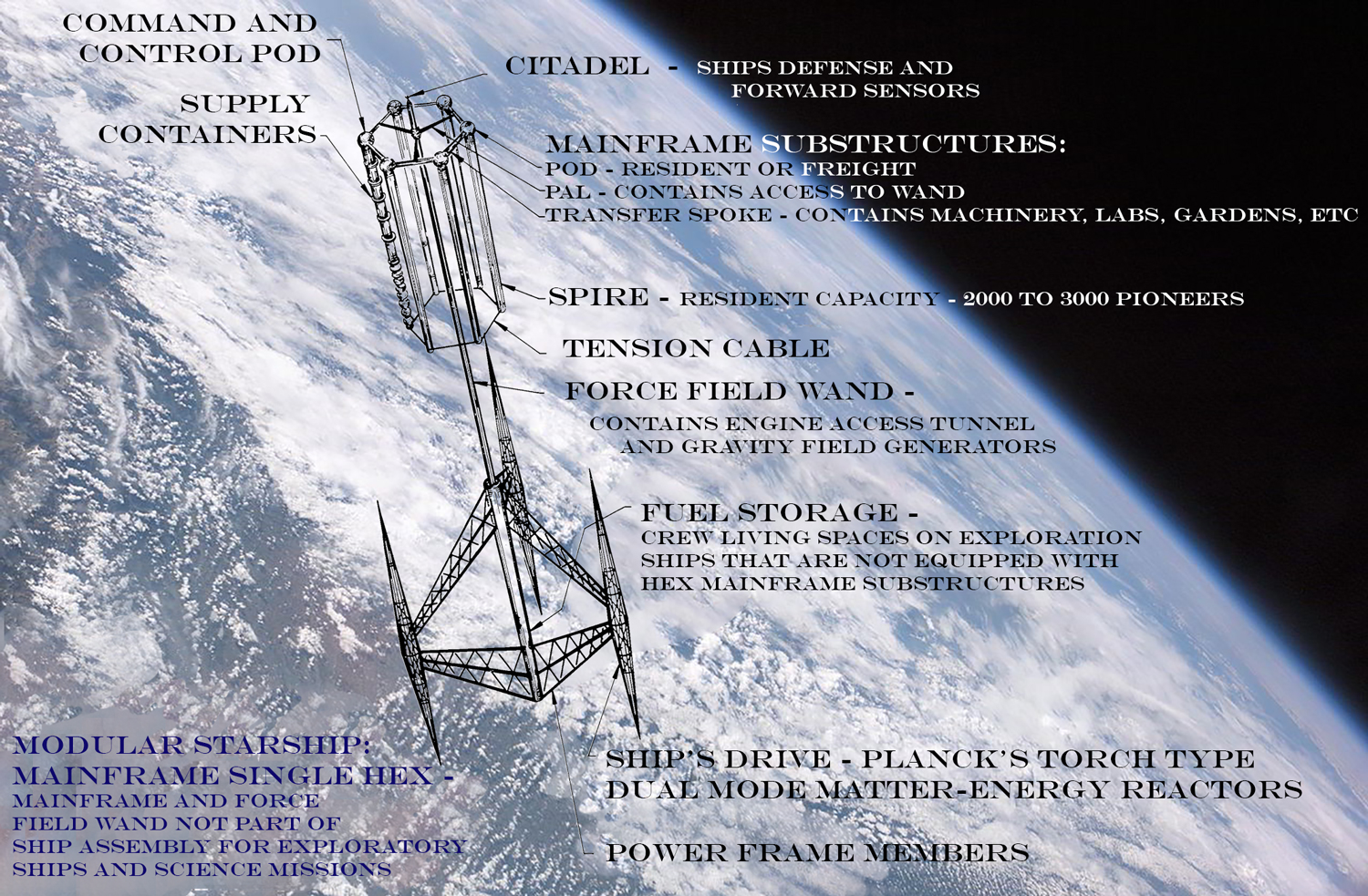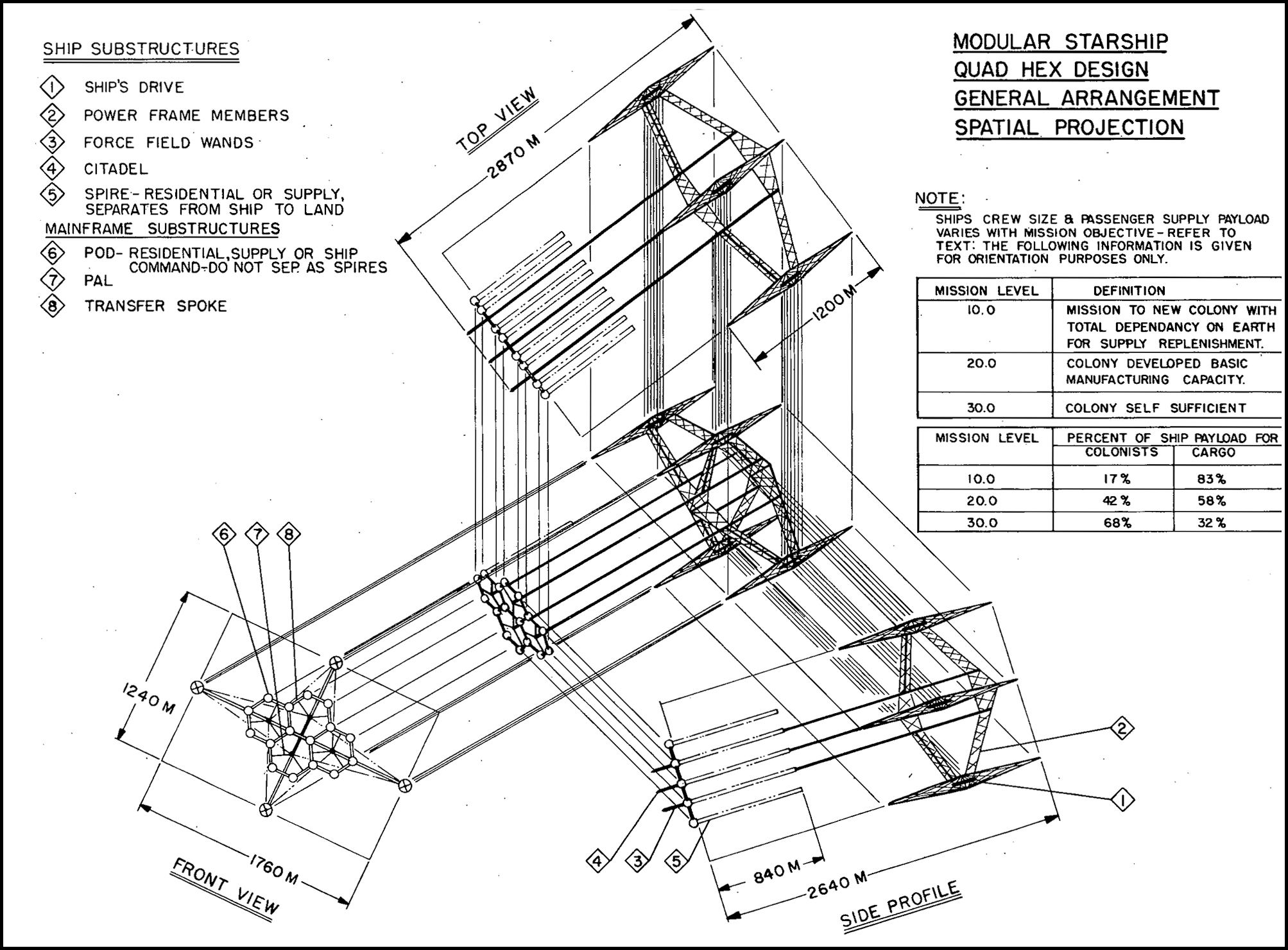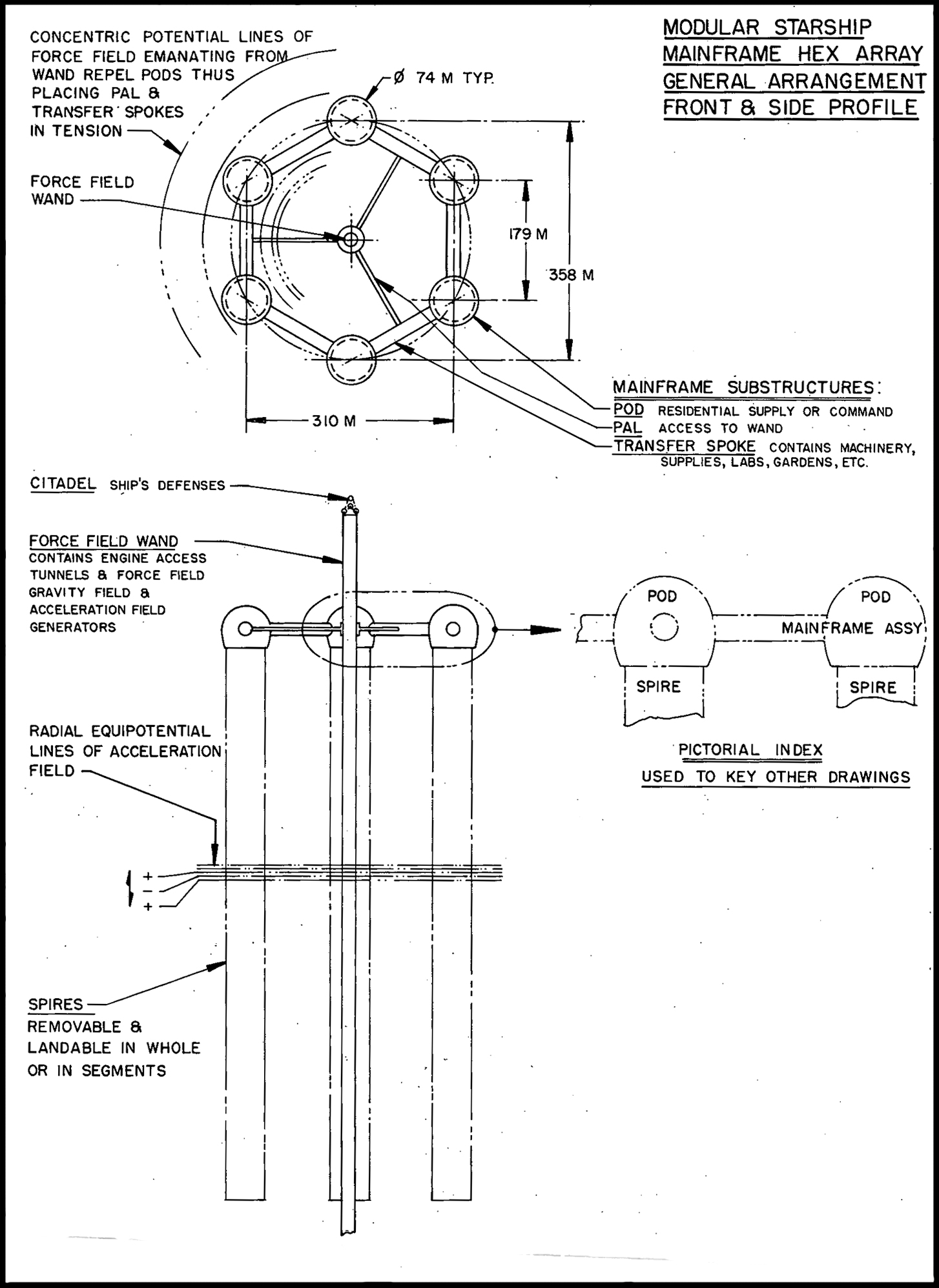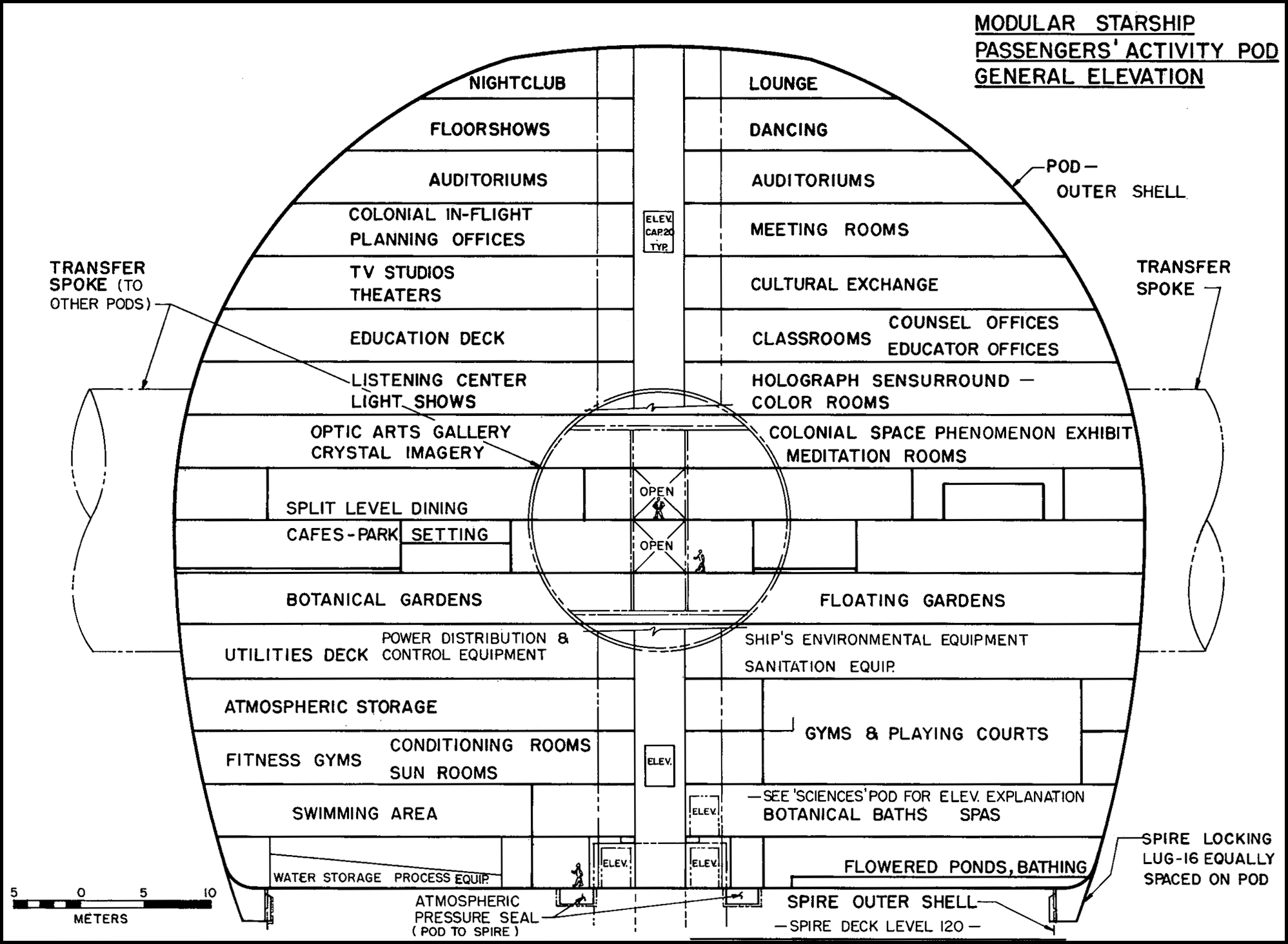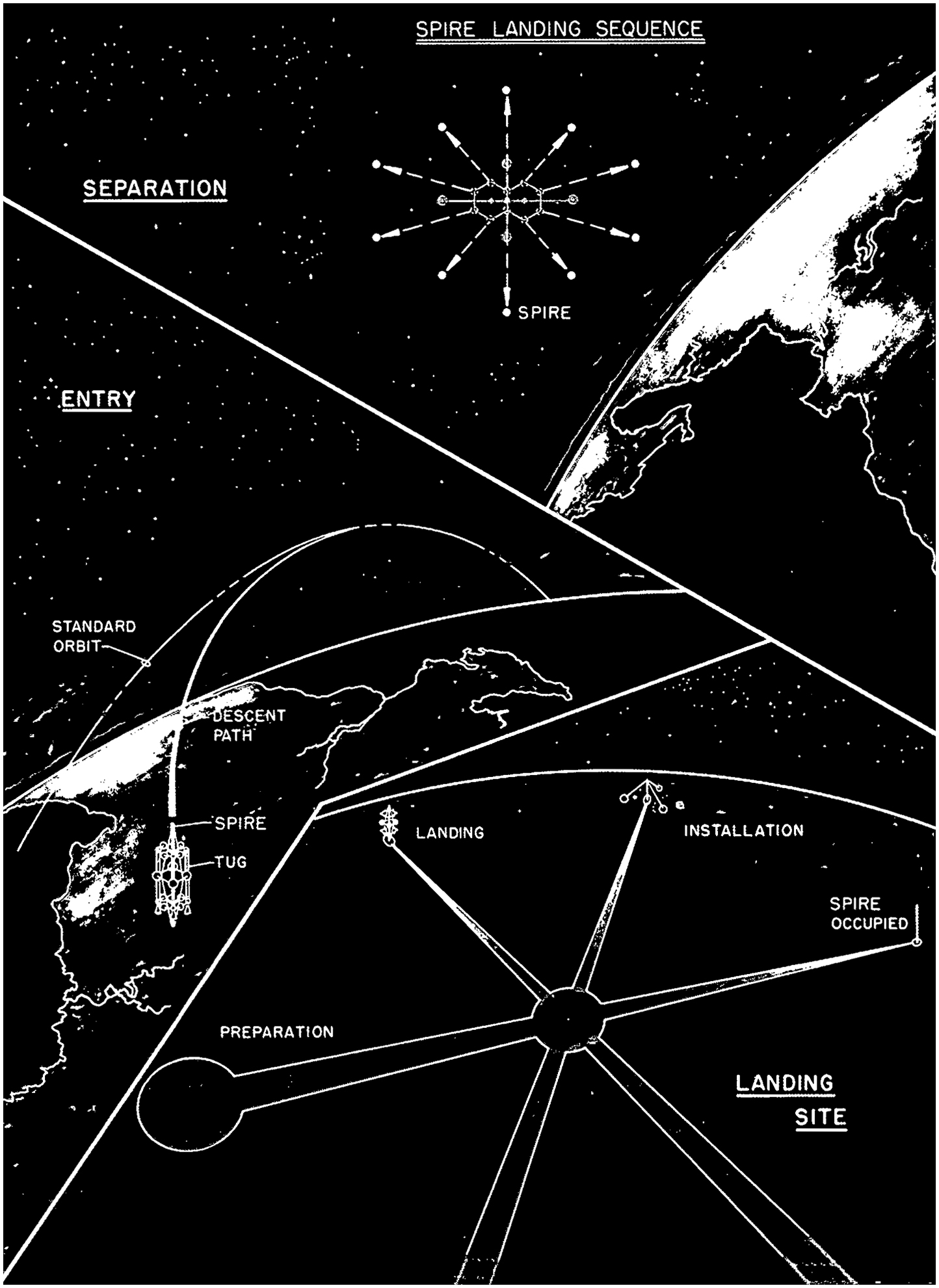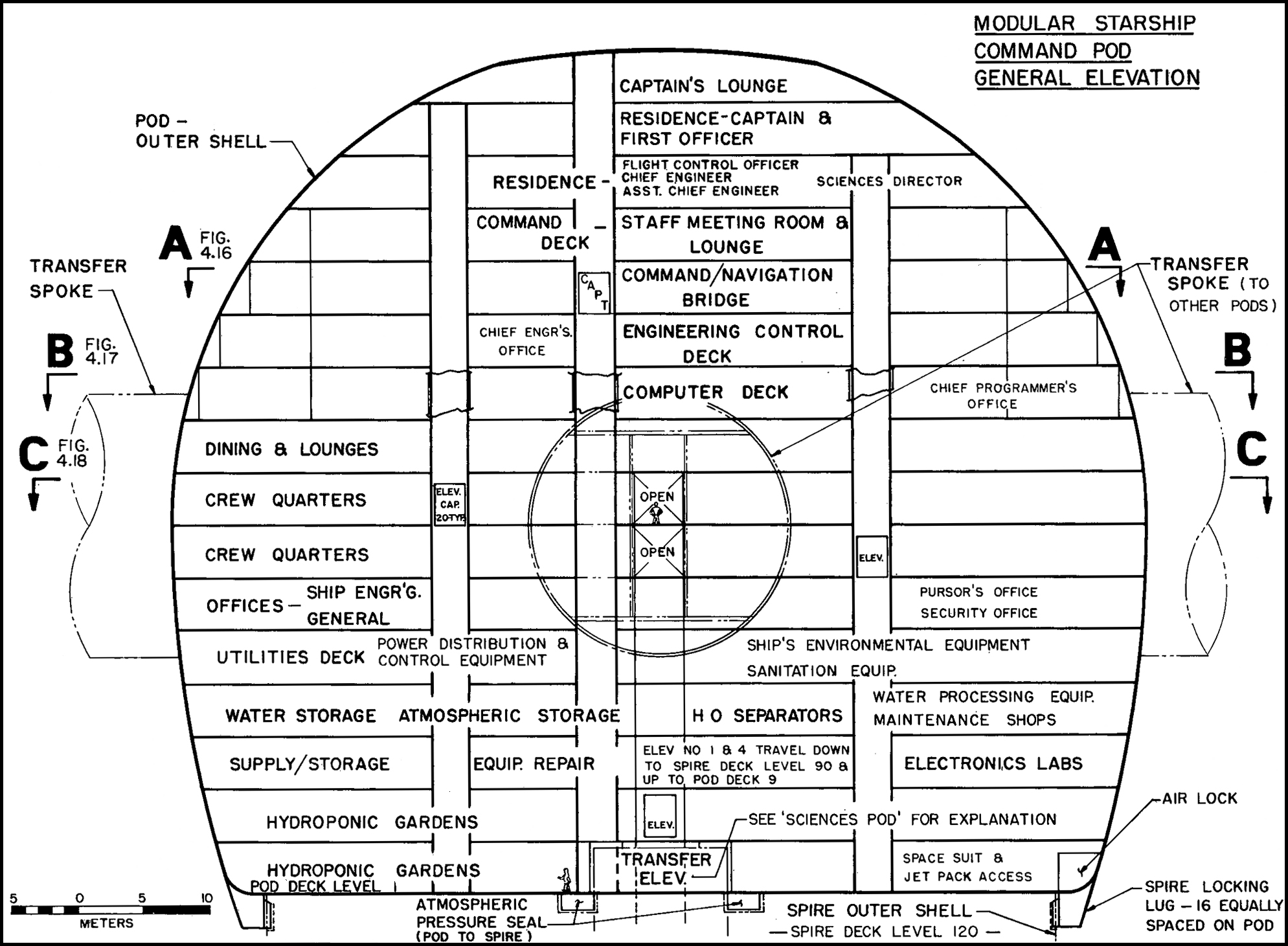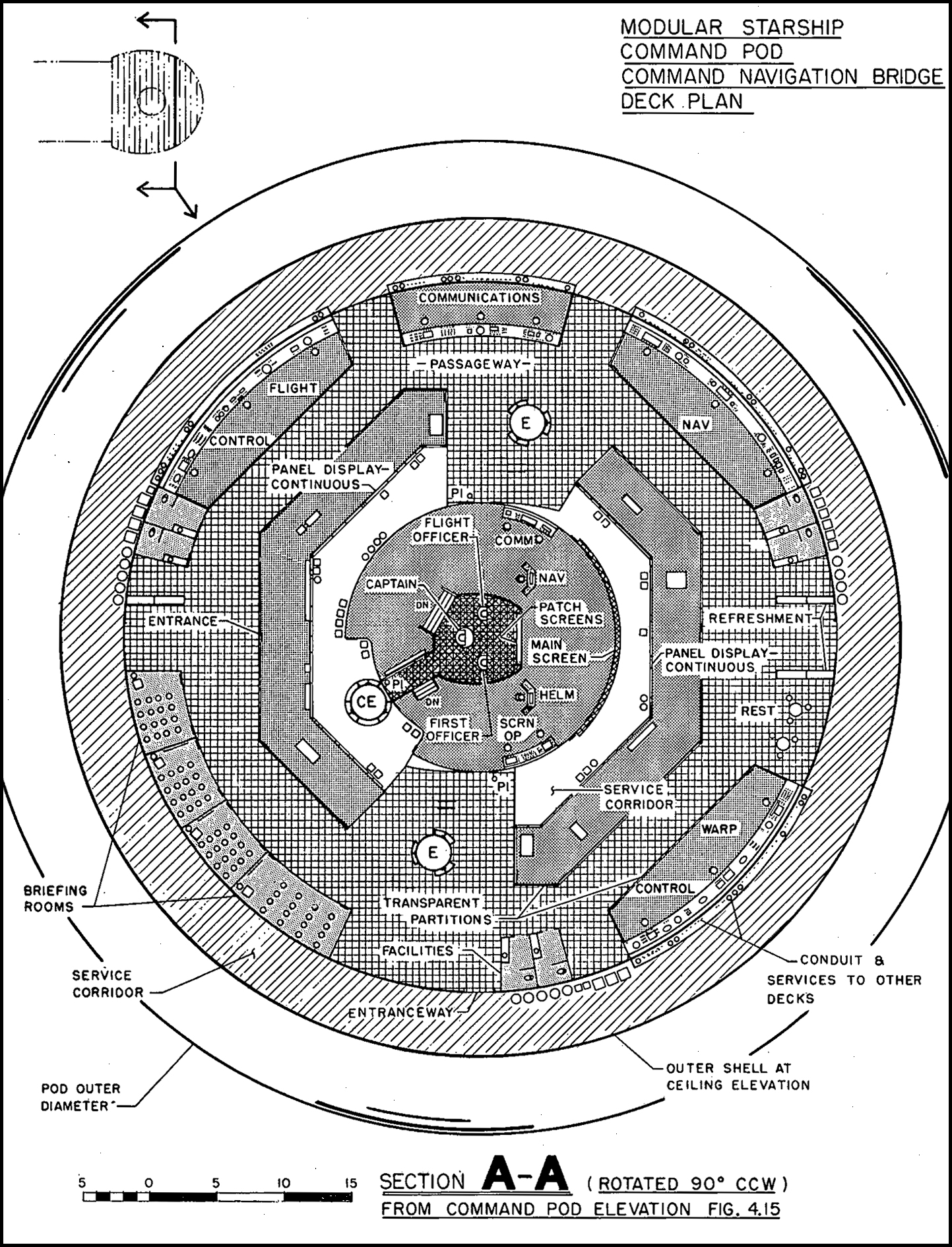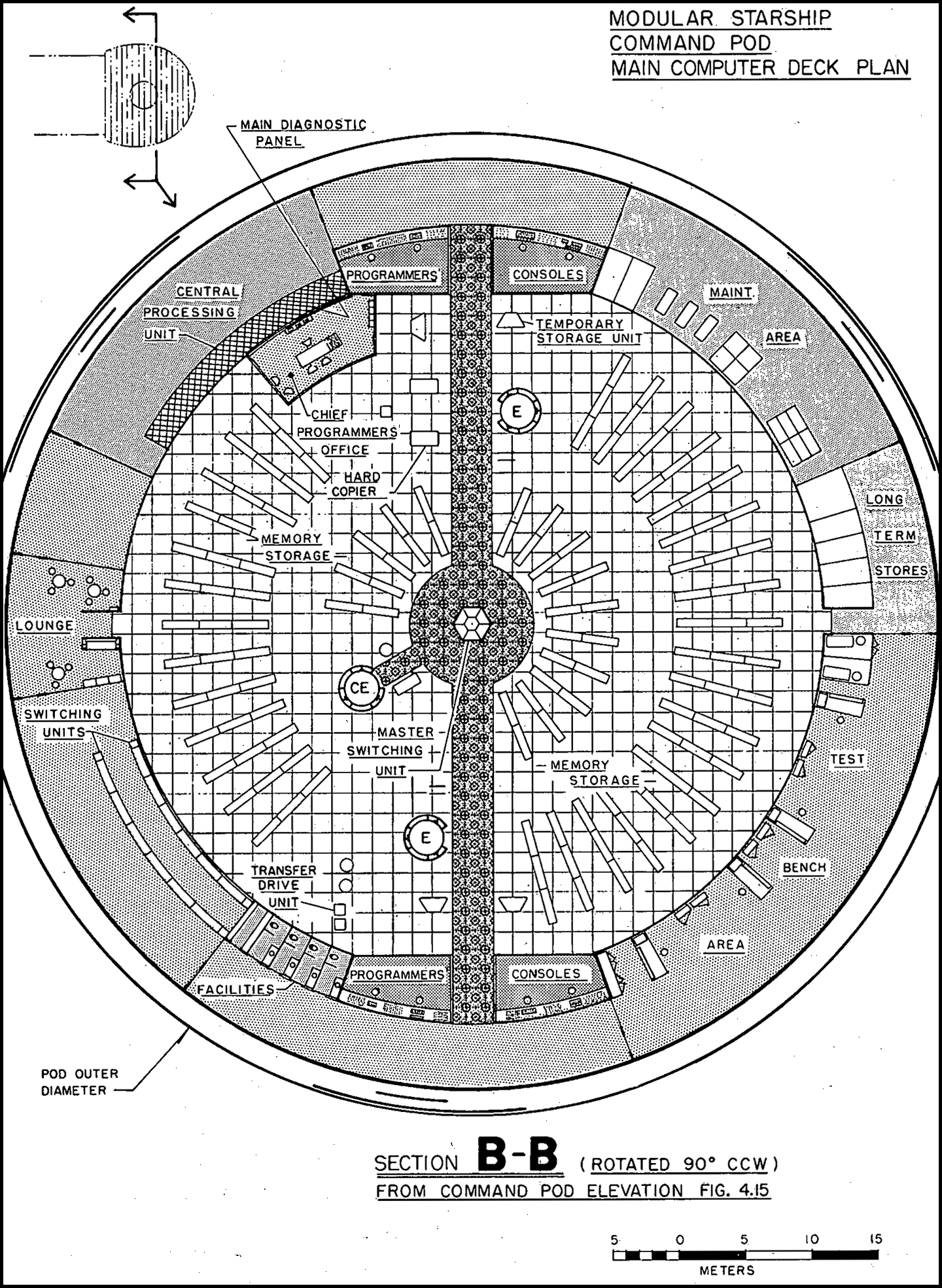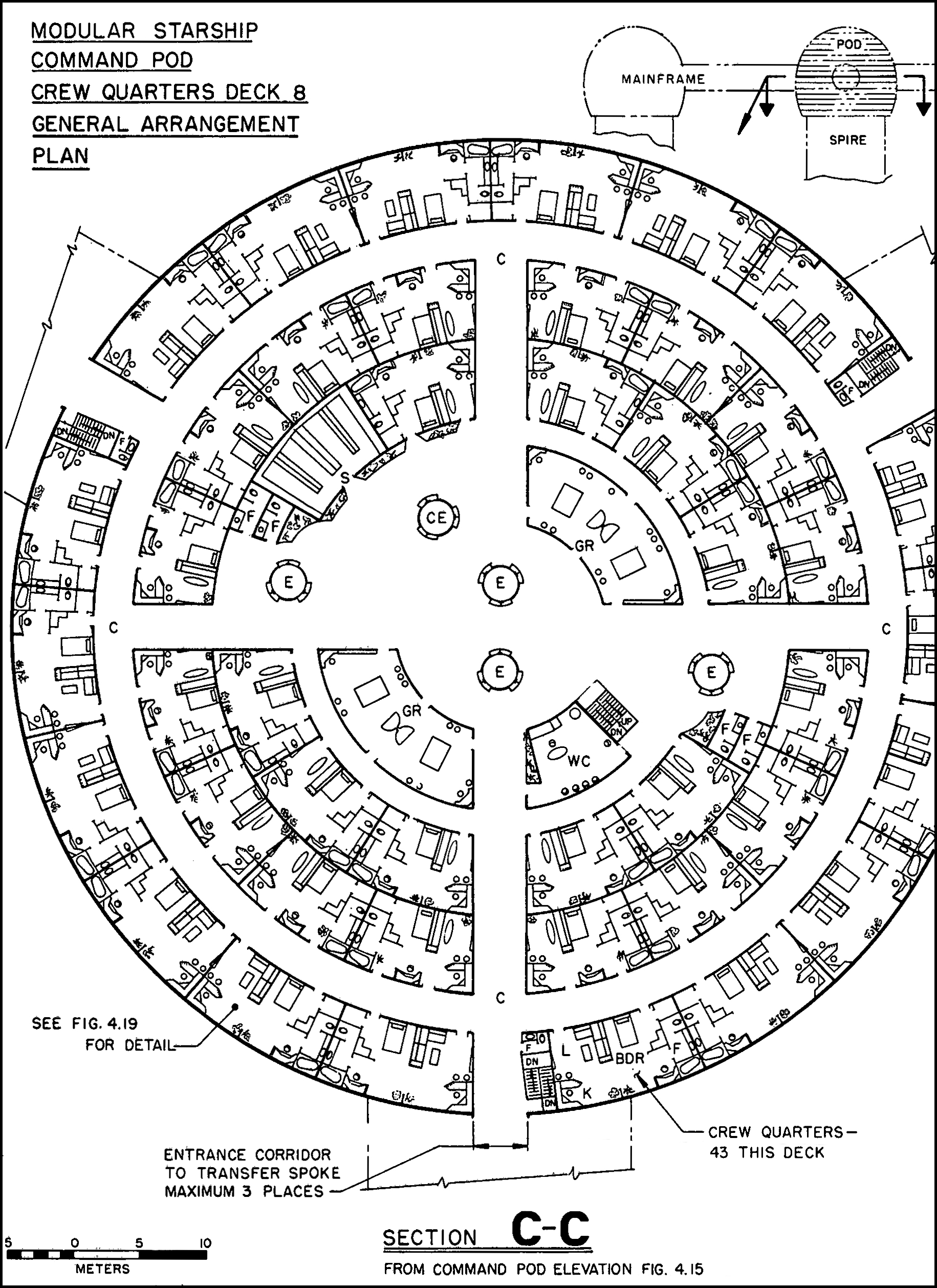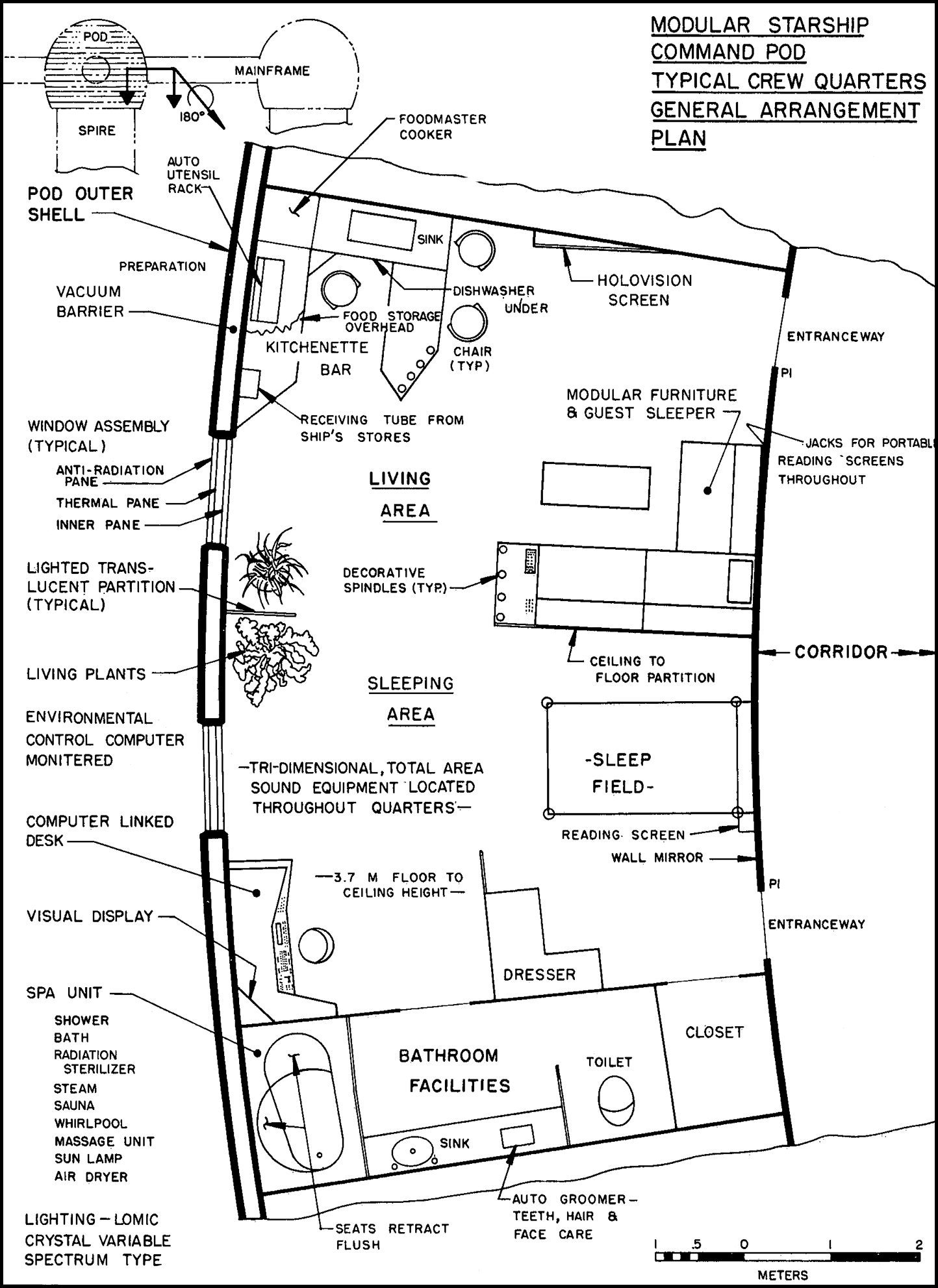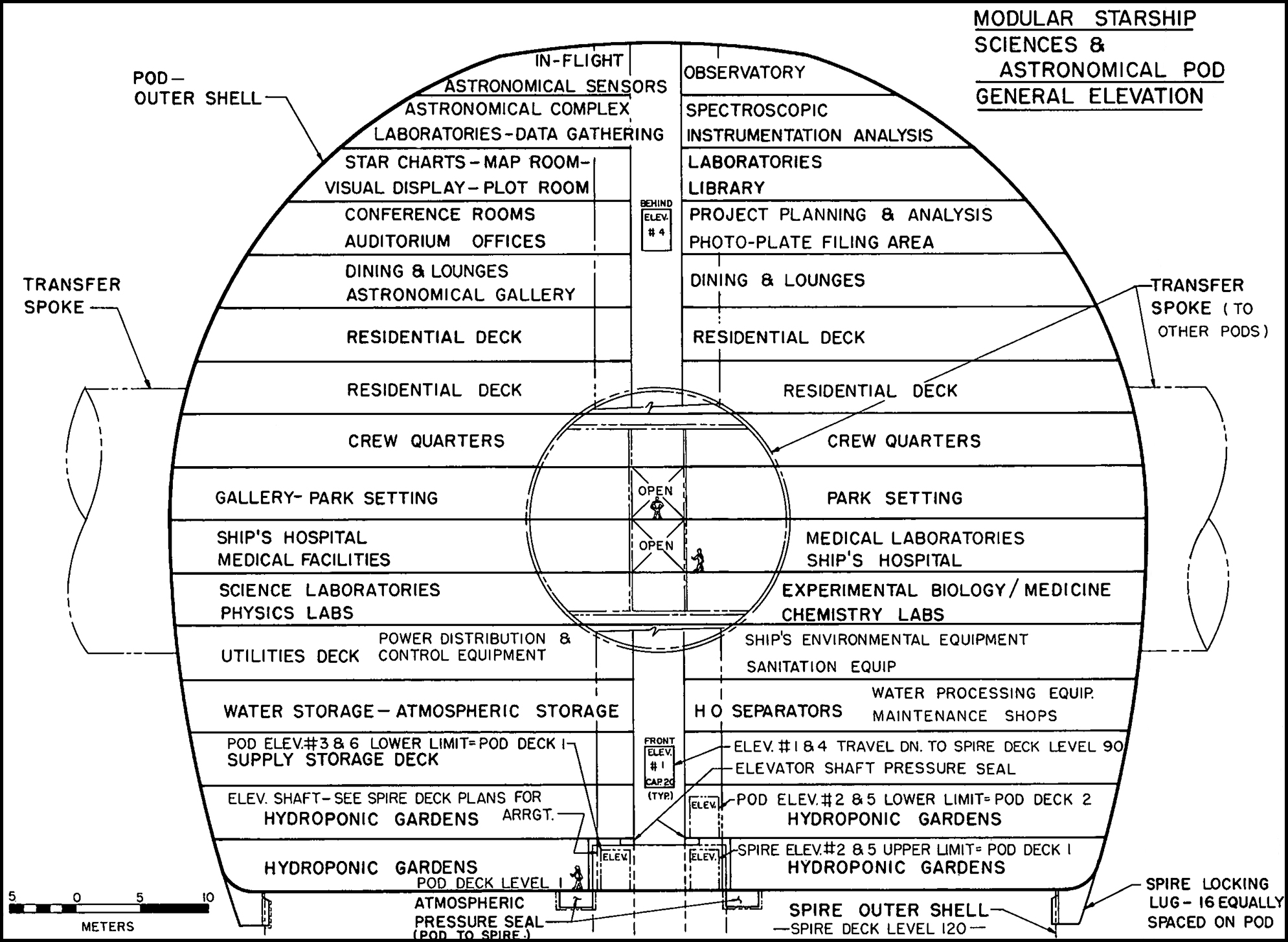Figure 4.1 – Modular Starship Used to Transport Colonists to Exoplanet Colonies
Figure 4.1 shows a modern starship, typical of the sort used to transport pioneers to the colonies today. Built from a set of standardized, modular components, this design offers great flexibility of mission and low cost. The three basic components of the ship are pods, spires, and photon drive engines. Pods and spires comprise the building blocks of the “mainframe,” the section of the ship that carries people and cargo. The engines, linked to fuel storage modules, comprise the “power frame.”
Cylindrical transfer spokes link the pods of the mainframe together into a hexagonal array. The spires that trail behind the pods contain most of the load-carrying volume, and a variety of special designs accommodate passengers or cargo to suit the mission. Pod access links connect the transfer spokes of the mainframe to a central cylinder called the “force field wand.” The wand ties the mainframe and the power frame together. It contains both power and control circuits and affords the crew access to the ship’s engines during flight. For missions requiring additional payload capacity, large mainframes can be constructed by adding additional pods and spires. Designers arrange the pods in hexagonal configurations like the cells in a bee’s honeycomb because it offers compactness, symmetry and flexibility. Figure 4.2 below shows a spatial projection of a much larger ship with four engines and a four hex mainframe. The scale on this drawing gives some idea of the enormous size of these vessels. The size of the pod, spire and engine modules does not change from one ship to the next; only the number of modules is altered.
Figure 4.2 GAILE Quad-Hex Starship General Arrangement
Figure 4.3 below illustrates some of the many configurations that can be built from the standardized modules. Higher thrust-to-payload ratios are desired for long-distance missions to allow longer jumps through hyperspace. Unfortunately high ratios can not be maintained in the larger vessels; they must sometimes make more than one hyperspace jump during a single crossing. The use of standardized modules greatly reduces the cost of ships by eliminating recurrent engineering costs and allowing shipbuilders to tool up for quantity production. Such standardization does not prevent manufacturers from upgrading engine designs or navigational equipment as improvements arise. On the contrary, the standard design actually facilitates such improvements because new subsystems fit easily into older vessels.
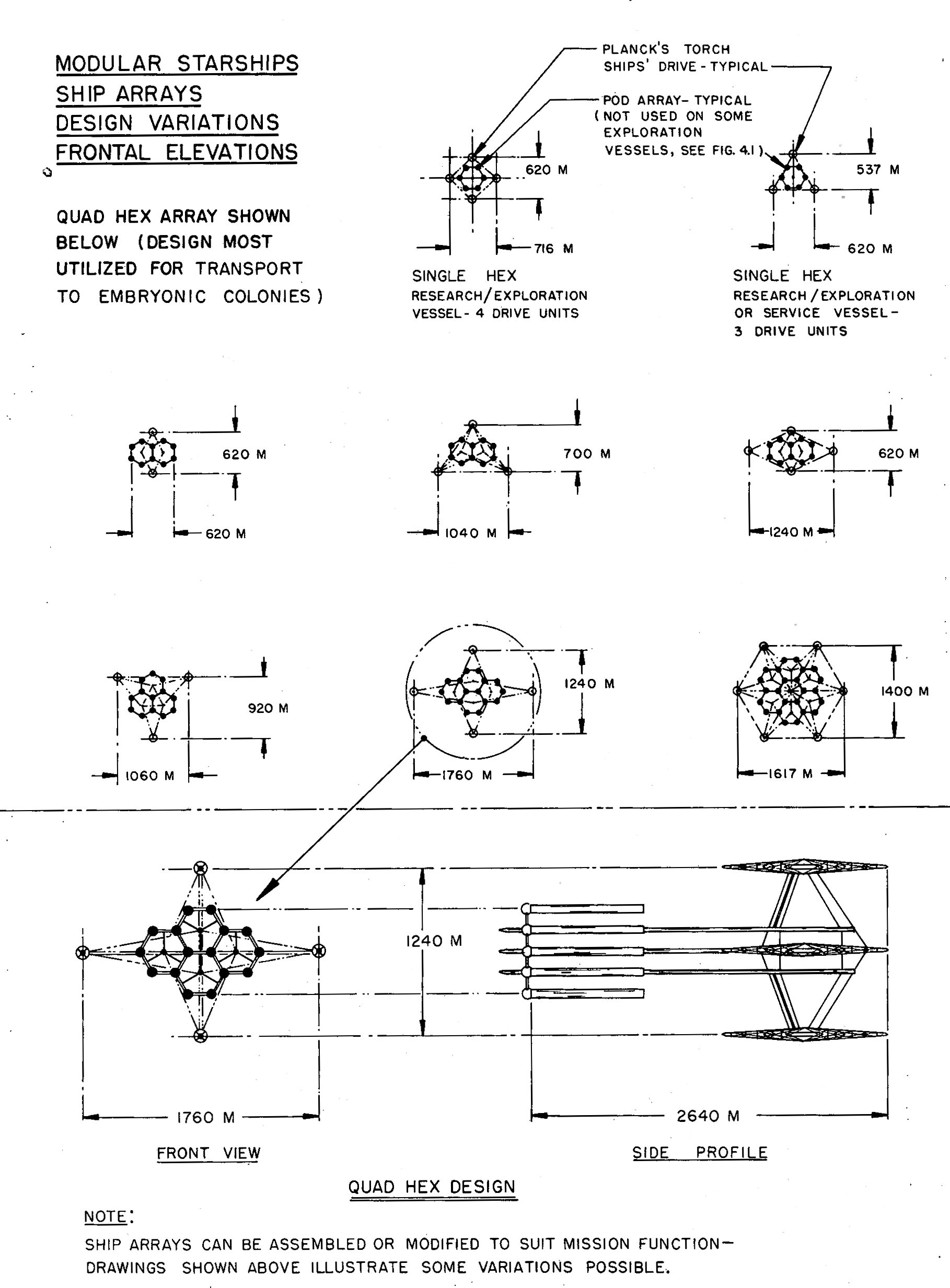
Figure 4.3 GAILE Modular Starship Configurations
The modular starship appears to be a thin and fragile structure because designers no longer need to use large amounts of material to withstand acceleration-induced forces. Instead, a complex system of fields, energized by the ship’s engines, binds the modules together. Today’s starships can accelerate at up to 16 g continuously and can momentarily attain higher levels than this during hyperspace transition.
Figure 4.4.001 – GAILE Starship Hex Array
Figure 4.4.001 shows an enlargement of a typical single hex mainframe. The g-field wand (also known as the force field wand) at the center of the hexagon generates a uniform anti-acceleration field which grips all six spires and pods. As the ship accelerates forward the anti-acceleration field cancels the effect of all but one g of acceleration within the ship. During negative acceleration (slowing), the anti-acceleration field’s polarity is reversed to prevent people inside from being thrown up to the ceiling. See Figure 4.4.002 below for a photograph of a force field wand under construction in earth orbit.

Figure 4.4.002 – Force Field Wand Under Construction in Earth Orbit
Little lateral force ever acts on the ship, so it is not designed to withstand much lateral loading. During turns, however, some lateral force tends to deform the hexagon. To prevent this, magnetic fields of opposite polarity act between the central wand and the spires to maintain tensile force within the transfer spokes and tension cables. This design saves expensive material and weight, since tension members can be made much lighter than compression members.

Figure 4.5 – GAILE Starship Life Support Spire
Figure 4.6.001 – GAILE Starship Supply Storage Pod
Figures 4.5 and 4.6.001 above illustrate typical spire and pod modules. The scale of these drawings indicates the tremendous carrying capacity of each of these structures. Comparing these two figures with hex array of Figure 4.4 shows that the decks of the spires and pods run perpendicular to the longitudinal axis of the ship. In other words, a person standing in the ship would look straight up to face the front of the ship and would look straight down to face the engines. Figures 4.6.002 and 4.6.003 below show a typical pod and spire manufacturing facility.
Figure 4.6.002 Typical Pod Manufacturing Facility
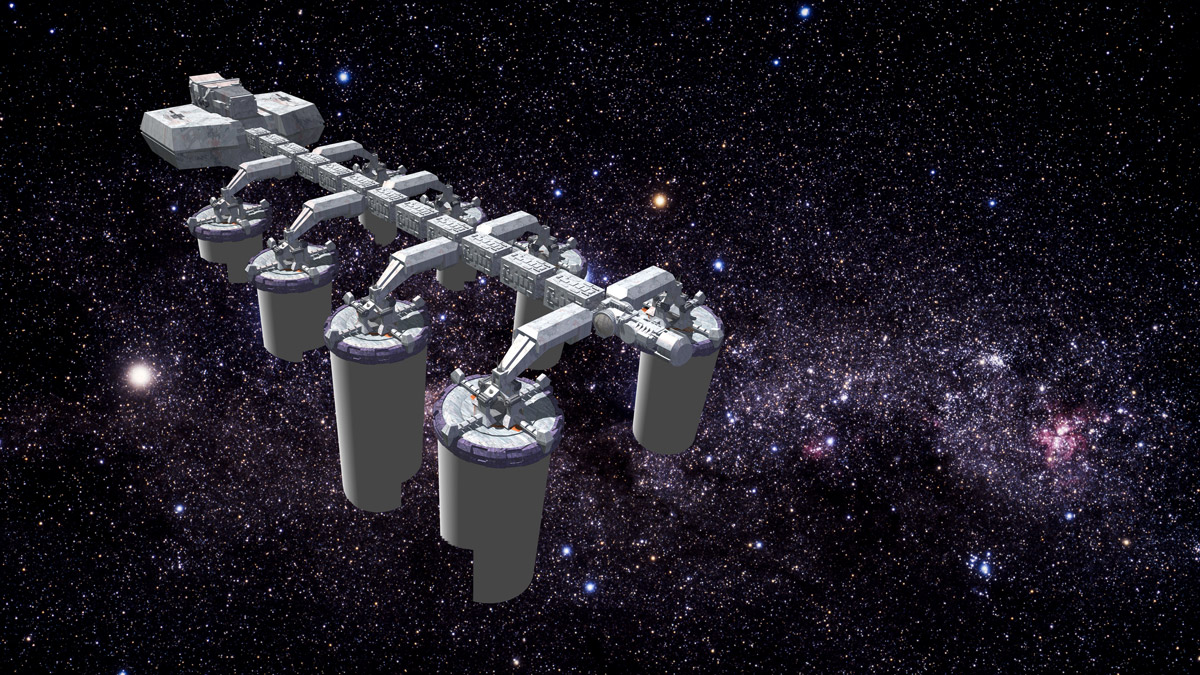
Figure 4.6.003 Typical Spire Manufacturing Facility
The citadel structure at the end of each force field wand houses three additional field generators that protect the ship and its passengers from collisions with foreign objects. At near light speeds, an impact between the ship and a particle no bigger than a grain of sand would melt a hole several inches in diameter in the strongest and most refractory of materials. Solid particles occur even less commonly in the interstellar void than they do in the space of our Solar system. Yet they do exist, ranging in size from fine dust to giant spheres several times the mass of the planet Jupiter! There is a slim but finite probability that a ship could collide with such a particle during the trillions of kilometers of an interstellar crossing, and just one such collision would be fatal.
Figure 4.7 below is a schematic profile of the ship’s defense fields. The familiar g-field offers the first line of defense. Physically identical to the anti-acceleration fields of the ship and the anti-gravity fields of levicars, the polarity of the citadel g-field is reversed so that it repels mass instead of attracting it. The field is focused into a beam which extends up to 100 million kilometers in front of the ship. When it encounters a particle at this range, it exerts just a slight force on both the ship and the particle. This gentle nudge is usually sufficient to deflect the particle from the ship’s path, just as the bow wave of a boat keeps floating debris from striking the hull.
The g-field grows stronger as the ship and the obstacle get closer until, within a certain critical range of the ship, sensors automatically activate the “weak field” generator, the ship’s second line of defense. The w-field neutralizes the weaker of the interatomic forces. This causes all matter within the field to break up into a cloud of free protons, neutrons, and electrons. A magnetic field, emanating from the citadel, captures the protons and electrons, forming an artificial “Van Allen belt” about the ship. Just before arrival, the crew de-energizes the magnet to release the charged particles to space. The g-field and conventional neutron shielding protect the ship’s occupants from the wfield’s neutrons.
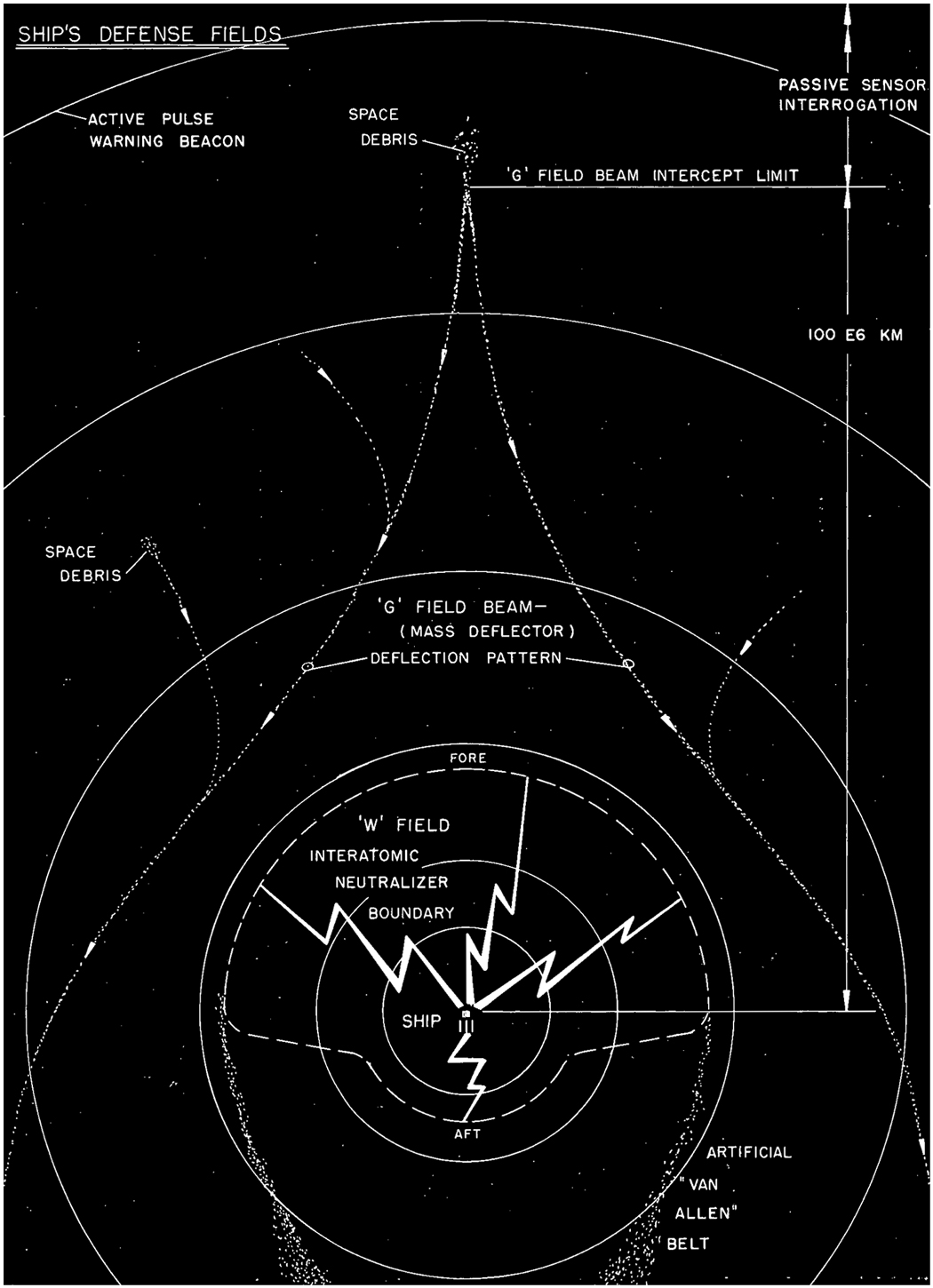
Figure 4.7 – GAILE Starship Defense Shields
GAIL starship’s take special precautions to avoid energizing the w-field when another starship is in their path. All vessels carry wideband transponders which emit conventional EM radiation over a series of specific frequencies. Association ships also monitor an even wider range of frequencies and employ long-range sensors tuned to detect unnatural energy sources just in case alien ships of unknown origin should cross their path. Unprovoked firing of the w-field at such an alien might be misinterpreted as a hostile act. Today’s starships employ the “photon drive,” sometimes referred to as the “Planck’s Torch” to accelerate them to the near light speeds required for hyperspace transition. The photon drive uses a high energy beam to provide “massless” thrust. It offers the most efficient conversion possible of matter into ship’s kinetic energy. Yet despite the photon drive’s advantages the inefficiency of their power reactors severely limited the payloads of early Planck’s torch ships.
Payloads increased dramatically following the development of the comprehensive unified field theory, a joint product of the Ardotian and Human civilizations which led to the conversion of matter into antimatter, in 2284. This provided the ultimate power source, since matter and antimatter, upon mixing, release 100 percent of the energy predicted by Einstein’s well known formula, E = mc². This breakthrough greatly enhanced Humankind’s ability to colonize distant worlds. For the first time, large amounts of people and cargo could be transported across distances of more than 25 light years. The colonization of Genesis and the mining of Mammon became practical.
Spaceship engines must annihilate an enormous amount of mass to reach near light velocities. Accelerating a payload to 98 percent light velocity and bringing it to rest again requires the destruction of about 100 times the mass of the payload! Payload-to-fuel ratios have changed little from the days of chemical rockets, only the speeds have increased. Since the advent of nuclear-powered space travel, hydrogen has served as the basic fuel. Because interstellar starships need enormous amounts of hydrogen, they obtain it from large, uninhabited planets, such as our Solar system’s giant Jupiter. Jupiter’s atmosphere is composed mainly of hydrogen. Prior to taking on passengers, the starships fuel from a low orbit around the planet. Because hydrogen is of very low density, even in liquid form, it is converted to a dense plasma for storage by stripping the protons of their electrons. The plasma, about 1,000 times as dense as liquid hydrogen and nine times as dense as lead, is stored within a magneto-gravetric field at more than 30,000° Kelvin. In this form it resembles the substance that makes up the white dwarf stars. The plasma conversion is not at all wasteful; only matter in the plasma state can be converted to antimatter. Jupiter may seem like a long way to go for fuel, but the only major source of hydrogen on Earth is its oceans. The people of Earth have deemed the permanent loss of large quantities of water and the consequent ecological upset unacceptable. Besides, compared with interstellar distances, a trip to Jupiter is a short hop.
Figure 4.8 below shows a typical photon drive engine. As the dimensions on the drawing indicate, it is a very large piece of equipment and a very expensive one too. Anywhere from two to six engines may be used to propel a starship, and the double-ended design allows the drive to provide reverse thrust without turning the ship around. The engines are mounted well aft of the inhabited sections of the ship and may be jettisoned individually if the reaction gets out of control (highly unlikely in view of the built-in safety devices).
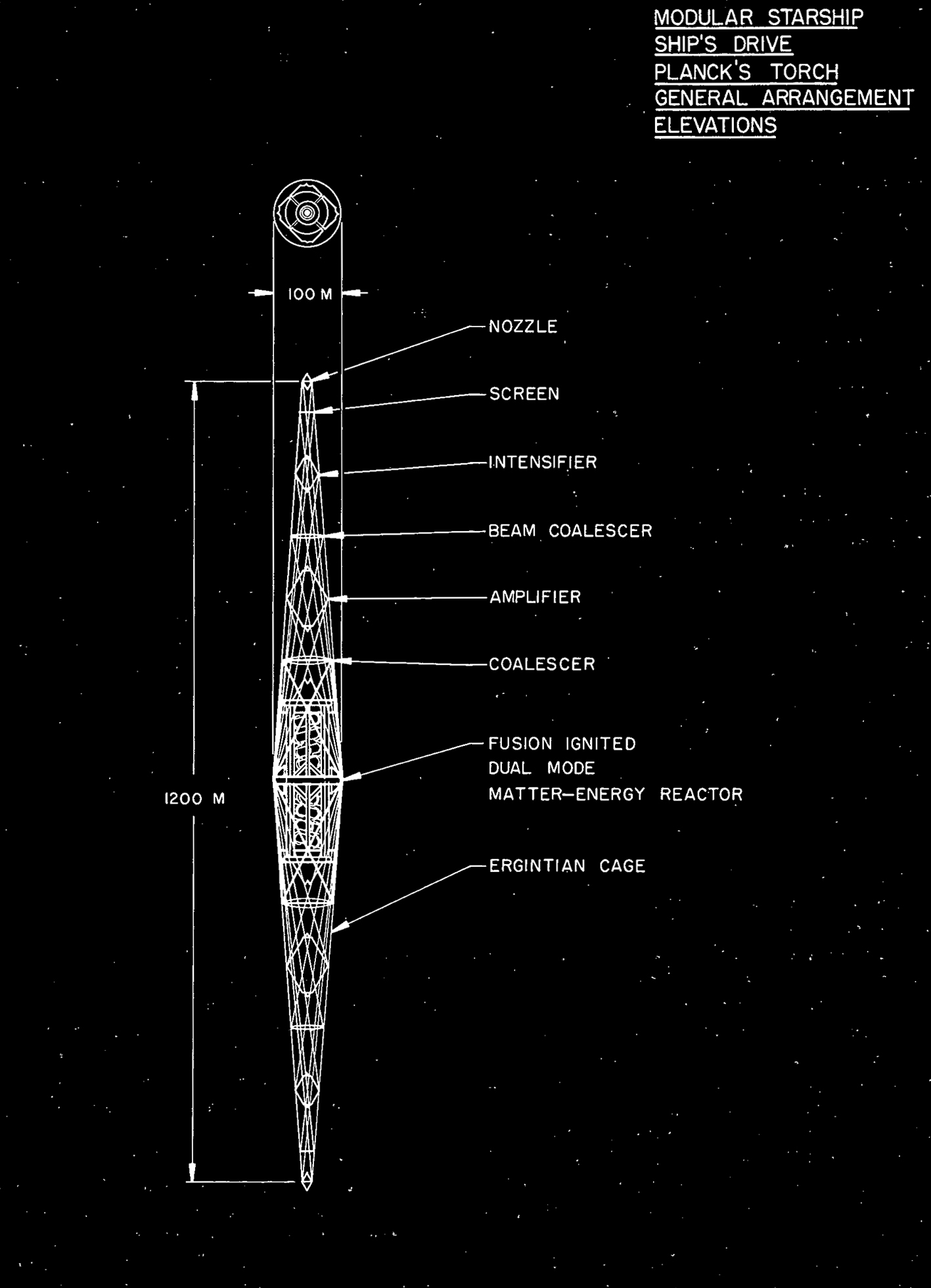
Figure 4.8 – GAILE Starship Planck’s Torch Drive
Life Aboard Ship
Since interstellar travellers must spend from nine to eleven weeks aboard their vessel, designers have tried to make the ship as comfortable as possible within the severe constraints imposed by interstellar travel. The ship provides all forms of life support for its crew and its thousands of passengers, including breathable air, water, heat, light, and food. Wastes must be recycled and air must be scrubbed of carbon dioxide and other impurities. To the greatest extent possible, the ship is designed to be a closed ecological system. Hydroponic gardens using artificial light grow the bulk of the ship’s food. The plants also serve to convert carbon dioxide into breathing oxygen. To minimize the weight of water carried, all waste water is recycled and purified. Some waste waters provide a nutrient base for the gardens. Ship’s water storage also serves as a compact supply of oxygen which can be electrolyzed to breathable form in emergencies.
The ship travels through an interstellar void whose temperature measures very near absolute zero. Though only a small fraction of the power of the photon drives need be tapped to provide heating for the passengers, a complex system of ducts and air movers is required to circulate air and heat throughout the ship. Walls are carefully insulated to prevent excessive thermal gradients and designers have minimized the machinery noise. In a closed environment, not only temperature, but humidity and odors also must be controlled to insure passenger health and comfort.
Human beings require more than the bare necessities of life when traveling in space. Privacy, companionship, recreation, and exercise all are needed for normal living, and it isn’t easy to fulfill such needs within the confines of a spaceship. The earliest pioneers avoided such problems by making the interstellar journey in a state of “suspended animation.” Most of the passengers and crew remained unconscious, at greatly reduced metabolic rates that actually slowed the aging process, but this technique posed many problems. First, the systems required to maintain suspended animation were even more massive than conventional life support equipment. At lower metabolic rates, environmental temperature had to be controlled very precisely. Hot and cold spots on the body’s surface also had to be prevented by a well-circulated cooling medium or tissue decay would set in. More than 1,200 liters of coolant per person had to be carried.
The complexity of life support for hibernating Humans made it both expensive and unreliable. Virtually all body functions had to be continuously monitored for each person, and automatic equipment was required to bring the hibernating traveller to consciousness if his individual life support failed. Such failures occasionally claimed lives, but more often the victim would be awakened to spend years of monotonous travel fully conscious. Induced hibernation took time to initiate and terminate. Ship’s crews spent months preparing pioneers on large colonial vessels for the voyage and still more months awakening them on arrival. Lastly, despite the advantages suspended animation offered, some of the crew had to remain awake throughout the entire trip to monitor the ship’s functions and the health of the unconscious passengers. The monotony experienced by these crew members on year-long shifts was difficult for most to tolerate.
The greatly reduced trip times resulting from the development of space warp obsoleted suspended animation techniques. Conscious passengers can use the months of travel time to prepare for their life on a new world. Each colony planet has unique life forms, geography, and Human culture, and every new arrival should have at least a rudimentary knowledge of them. During the trip, all pioneers attend daily orientation classes covering almost every aspect of life, including flora and fauna, geography, economic, and political structure, types of housing, local cooking, and foods and colonial history (if any).
Pioneers also use the time aboard ship to plan the first months and years of their lives on their new world. The career they will pursue, the location where they will settle, and the type of home they will ultimately build all require careful consideration. During the course of the trip, the crew gradually adjusts the ship’s gravity and atmospheric composition from Earth normal to that of the destination planet. The change, though barely perceptible to the passengers, gently acclimates them to the new conditions.
Life support spires (figure 4.5) contain most of the pioneers’ accommodations on board the starship. On missions to the embryonic (post-Brobdingnag) colonies, the spires are detached from the pods and lowered to the surface to serve as temporary housing for the new immigrants. The developed colonies do not need such supplemental housing, nor do they require imported equipment. Ships bound for these planets also carry passengers in the pod structures as shown in figure 4.9 below. Room size and design in both the pods and spires are similar.

Figure 4.9 – GAILE Starship Residential Pod
GAILE apportions living space on starships to family units. Single people get single rooms with private baths, and double-room suites accommodate married couples without children. Larger families with children live in multi-level apartments. Figure 4.10 below shows a typical deck plan in a residential spire. An elevator and utility shaft form the central core of the spire while individual living units and recreation rooms line the outside wall.
Symbol Interpretation for symbols used on ship drawings
C – Corridor
CE – Captain’s elevator
DF – Drinking fountain
DN – Down
E – Elevator
F – Facilities
GR – Game room
K – Kitchen
L – Living room
PI – Personnel identification station (computer linked)
S – Stores
TYP – Typical (of other symbols shown on drawing)
V – Vending machine
WC – Watch captain
Table 4.1
Figure 4.10 GAILE Starship Residential Spire Floor Plan
The area in between, known as the “common,” provides needed open space, a place for floor meetings, and a waiting area for the elevators. Figures 4.11 and 4.12 below illustrate a typical multilevel family living unit. Each unit is completely furnished and carpeted. It offers all the convenience and luxury appliances found in an Earthbound apartment. An environmental control system regulates temperature, air circulation, humidity, and sonofield intensity to suit the occupants. An entertainment center plays music and shows holofilms retrievable from the library in the ship’s computer. A data terminal allows access to written material in the library as well as the computer’s run and programming facilities. Pioneers can access anything in the ship’s library except the ship’s technical manuals. Triple buffering protects the ship’s navigational data and programs from computing errors by passenger users.
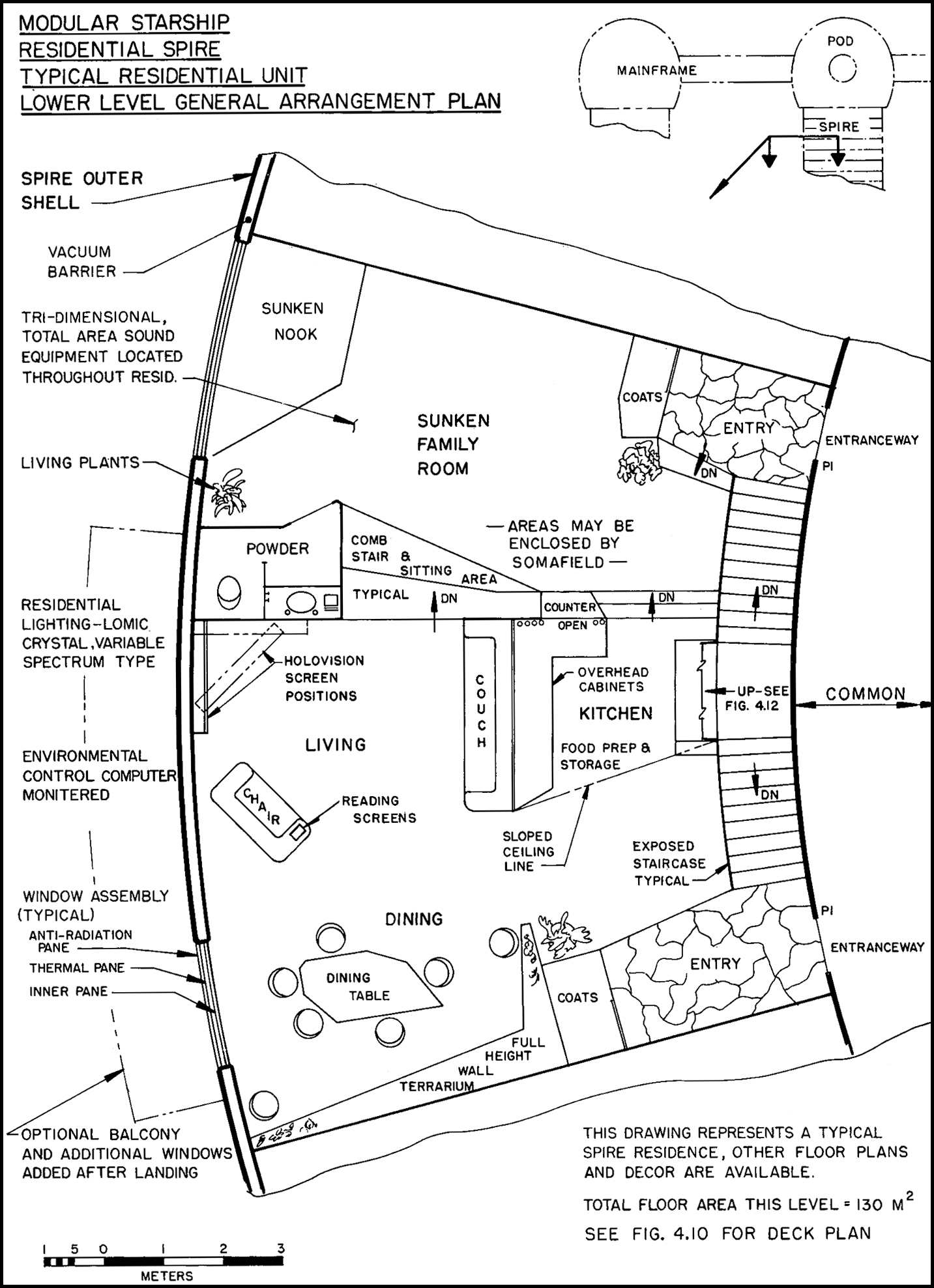 Figure 4.11 GAILE Starship Spire Family Living Unit 001
Figure 4.11 GAILE Starship Spire Family Living Unit 001
 Figure 4.12 GAILE Starship Spire Family Living Unit 002
Figure 4.12 GAILE Starship Spire Family Living Unit 002
All multi-person living units come equipped with mini kitchen facilities consisting of a preservator, a food master, and micro-oven. Common dining facilities can also be found in each spire for those who don’t wish to cook their own meals. Colonist-cooks direct meal preparation, and every pioneer who eats in the dining rooms must spend part of the trip assisting with meal preparation and serving. The ship’s crew is too small to provide this service to the large number of passengers that each vessel carries, although the crew provides technical assistance in servicing the food machinery.
Passengers need more than just living quarters aboard a starship. They also need instruction, exercise, and a little fun during their long voyage, so each ship carries one or more pods devoted to these purposes as shown in figure 4.13 below. The activity pods serve as focal points for all passenger activities during the voyage, and as much as 30 percent of the ship’s crew may serve as counselors and maintenance personnel in support of these activities.
Figure 4.13 GAILE Starship Recreational and Activity Pod
All pioneers are urged to exercise daily because the confined and sedentary life aboard ship does not keep them in fit condition. Colonial living, in contrast with life on Earth, requires more physical strength and stamina, especially during the first months after arrival. Exercise facilities in the Activities Pods include a swimming pool, several automated exercise gyms, a dance floor, and courts for the most popular games on the destination colony.
Diversionary activities aboard ship emphasize things that pioneers can do for themselves. These include theaters for plays and concerts, recreational gardens, passenger-operated cafes and a holovision studio for producing shows and information broadcasts. No one has an excuse to be bored!
Figure 4.14.001 GAILE Starship Spire Detachment and Landing Sequence to Colony Exoplanet

Figure 4.14.002 Spire Living Unit on Romulus
Upon arriving at the colony planet, the crew detaches the spires for landing on the planet. Figure 4.14.001 illustrates the landing sequence. A space tug, transported with the first pioneering vessel, meets the ship and lowers the spires one at a time to the surface. The spires land at prepared sites and may be guyed to withstand surface winds. On the surface, spires may be left as one great tower, or they may be cut into smaller segments and spread around the countryside. Spires generally serve the colony planet for many years. After the original pioneers move out, the structures are converted to even more spacious apartments, offices or laboratories. Figure 4.14.002 shows a Spire Living Unit on the planet Romulus that is ready to occupy.
Starship Crews
Professional crews command and operate all GAILE starships. All officers graduate from the GAILE space academy and their training is augmented by years of actual experience in space. A typical starship captain logs from twenty to forty years in space prior to attaining his command. Starship crews perform all critical operation and maintenance tasks aboard ship, but because the cost of providing crews is so high, GAILE leaves non-critical chores, such as cooking, cleaning, class instruction, and direction of social activities to specially trained and compensated pioneers.
Except when making minor repairs in the spires or when unloading cargo, the crew lives and works entirely in the pods and spokes of the mainframe (refer to figure 4.1). The pods contain not only crews quarters, but all of the critical equipment that must remain with the ship after detaching the spires.
The Command and Navigation pod shown in figure 4.15 below forms the brain and nerve center of the ship. It houses the ship’s bridge, main computer, general offices and the quarters of all officers and flight crew. Crew members responsible for non-flight operation, such as maintenance, scientific observation and passenger services live in other pods of the ship.
The captain’s quarters and those of the other high level officers are located above the bridge. This affords them some measure of privacy, since the ship’s computer controls access to all decks above the general offices. Cameras in the elevators enable the computer to recognize and admit only those crew members who live in the command pod. No crew member except the top officers may enter the bridge, engineering or computer decks except during their assigned watch hours, and only the captain or the first officer may alter watch assignments.
Figure 4.15 GAILE Starship Command and Navigation Pod
Figure 4.16 GAILE Starship Command and Navigation Pod Bridge
The ship’s bridge, shown in figure 4.16 above , contains no windows or viewing ports. Such openings would have little purpose, since at near light speeds the unaided Human eye could not see an object in time to avoid collision. Even during orbit insertion and unloading operations, cameras provide a more complete view of the surroundings than windows could afford. Normally the flight crew controls the ship exclusively from the circular room at the center of the bridge deck, called the “inner bridge.” The main screen, covering one quarter of the inner bridge walls, employs a free-format display that allows the crew to project a single large image or a variety of smaller images. During spire undocking, for example, the captain can simultaneously display a picture of every spire in space, as well as a view of the planet below. Data as well as pictorial images can also be displayed in both digital and graphic form. A smaller “patch screen” located at the end of the command pedestal allows the captain or watch officer to display data he wishes to see, while leaving the main screen display uninterrupted.
A watch maintained on the inner bridge at all times consists of a watch officer, a navigator, a helmsman, and a communications officer. On the engineering control deck below, two flight engineers continuously monitor the ship’s power and life support functions. The proximity of the bridge to the senior officers’ quarters makes them available around the. clock to cope with unusual situations. The navigator and helmsman do not really plot the course or steer the ship. Steering of the ship is performed automatically by a section of the main computer, reserved exclusively for this purpose.
Human reactions cannot cope with the high speed of interstellar travel or the complexities of relativists inertial guidance. Yet the watch officers do perform important functions. During the early part of the trip, the navigator and helmsman work continuously to prepare for the hyperspace maneuvers, using the computers to calculate the length of the jump and cross-checking against the ship’s actual velocity and position. After the hyperspace jump, the watch must update and correct optical settings in order to place the ship on the exact course to its destination. The watch also must be present to cope with emergencies, alarms, and malfunctions. Often they must dispatch maintenance personnel to calibrate or repair sensors, or to reprogram the computer.
The “outer bridge” houses still more control and monitoring panels. These are staffed during the first shift only. Crew members perform routine tests of all ship’s systems during these hours and schedule maintenance as required. The main communications panel on the outer bridge also handles interplanetary data transmission as described in the next subsection.
During the transition to and from hyperspace, called “warp maneuvers,” crew members occupy every station on the bridge. Both the captain and first officer are always present, and two screen operators assist the communications officer in controlling the bridge displays. The chief navigator, assisted by two computer programmers, assists at the warp control panel. This contains special displays and programming functions used only at this time. There is still a measure of uncertainty when travelling in hyperspace. Even today, starship crews cannot calculate the precise point where the ship will emerge. Though the actual jump through hyperspace seems instantaneous, warp maneuvers generally last several hours. Crews must check and recheck calculations before programming the final trajectory into the navigation system, and after emerging, it may take additional hours to determine exactly where the ship is. A small miscalculation during this critical period could place the starship light years from its planned destination.
Figure 4.17 GAILE Starship Main Computer Deck
Figure 4.17 shows the most critical equipment area on the ship-the main computer deck. It lies immediately below the engineering deck, a logical choice because of the high degree of interconnection between these two areas. The main computer controls and monitors virtually every ship function from passenger life support and space conditioning to the photon drive engines. The computer appears very large by modern standards because a high degree of redundancy is designed into the entire system. Every computer function has been installed in triplicate and all interconnections have been arranged to-minimize data-loss-in-the-event of fire or other damage. Total loss of the main computer would literally incapacitate the entire ship. Small microprocessors located throughout the vessel would maintain life support and emergency communications equipment would let the ship call for help, but both the ship’s helm and engines could no longer be controlled.
GAILE launches probes on rigid schedules and along predetermined paths to avoid collision with starships. Occasionally a probe crosses the path of a starship and is destroyed by the ship’s w-field beam. Sometimes probes veer off course and head directly toward an inhabited planet. To guard against this, each probe contains a self-destruct mechanism which senses the approach of a massive object. Should this malfunction the self-destruct mechanism may be activated by maser from the target planet, or the planet’s w-field defense may be used to destroy the errant probe.
The exchange of information between planets forms the cornerstone of all GAILE’s programs. Earth acts as a relay station for information between all of the colony planets, since the cost of exchanging probes between each colony would be prohibitively expensive. Earth also provides the common link to the other GAILE species, tying Earth’s remotest colony to the remotest Chlorzi and Ardotian worlds. Though most information exchanged between the planets is scientific or technical in nature, pioneers can also use this great communications system to send personal messages. Though one cannot switch on the telescreen and talk directly to one’s parents on Earth, pioneers can send written letters, recorded monologues and personal pictures in the probes. The round-trip time for a single “letter” generally ranges from one to four months, though many pioneers send several messages without waiting for a reply.
Though it would take a major technological breakthrough to enable people to converse with the colonies instantaneously, ship and probe builders are continuing to design faster vehicles that will bring our worlds closer together. Someday round-trip voyages between the stars may be affordable by everyone.
The ship’s flight crew lives in the middle decks of the command pod and the rest of the crew has similar quarters in other pods of the mainframe. The crew on immigrant vessels typically numbers three to five percent of the passengers, and includes not only the flight crew, but maintenance personnel, medical staff, counselors and science staff as well. Figure 4.18 below shows a typical crew’s residence deck. GAILE provides crew members with very spacious and comfortable quarters, for they spend far longer amounts of time in space than the pioneers.
Figure 4.18 GAILE Starship Crew Residence Deck
Figure 4.19 GAILE Starship Crew Compartment Floor Plan
Figure 4.19 shows a typical apartment for a single crew member. It contains all the comforts and conveniences of a modern home on Earth and affords the crew member a private place to relax and read or watch holovision as well as a place to sleep. Though most crew members take their meals in the dining halls, a small kitchenette allows them to fix snacks or to cook meals if they enjoy doing it. This typical quarter is approximately the size allotted to married pioneers.
Figure 4.20 GAILE Starship Science Pod
Ships bound for remote planets such as Romulus or Athena will carry a scientific study pod. Since the ship is approaching the limits of explored space, it provides a unique platform for astrophysical observations. Figure 4.20 illustrates a typical sciences pod. In addition to a variety of scientific and medical laboratories, it includes extra residential quarters for the scientists GAILE wishes to send on round trips to one of the colonies. To be invited on such a trip is a great honor and privilege. Few Earthbound scientists who work with data from the other planets ever have the chance to visit them.

